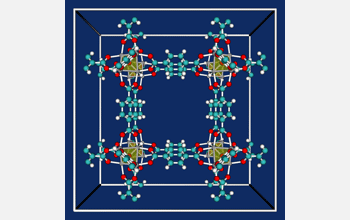Multimedia Gallery
New Nanoporous Materials
A metal-organic framework (MOF) having corners made from Zn40 and benzene dicarboxylate linkers. This cubic structure has pores of approximately 1.4 nanometers in diameter.
New nanoporous materials may be used in the future to pack more fuel into the tank of a hydrogen-driven vehicle or a fuel cell-powered cell phone, or may be used as catalysts to reduce auto emissions. Researchers use TeraGrid resources to simulate how the materials will perform.
The research is being performed by Randy Snurr, a chemical and biological engineering professor at Northwestern University, and colleagues Krista Walton, a chemical-engineering professor at Kansas State University, David Dubbeldam and Houston Frost
To learn more about this exciting research, see the TeraGrid news release "A Nanoporous Material in Your Tank." [Research supported by National Science Foundation grant CTS 05-07013.] (Date of Image: 2007)
Credit: David Dubbeldam, Northwestern University
Images and other media in the National Science Foundation Multimedia Gallery are available for use in print and electronic material by NSF employees, members of the media, university staff, teachers and the general public. All media in the gallery are intended for personal, educational and nonprofit/non-commercial use only.
Images credited to the National Science Foundation, a federal agency, are in the public domain. The images were created by employees of the United States Government as part of their official duties or prepared by contractors as "works for hire" for NSF. You may freely use NSF-credited images and, at your discretion, credit NSF with a "Courtesy: National Science Foundation" notation.
Additional information about general usage can be found in Conditions.
Also Available:
Download the high-resolution JPG version of the image. (1.3 MB)
Use your mouse to right-click (Mac users may need to Ctrl-click) the link above and choose the option that will save the file or target to your computer.

